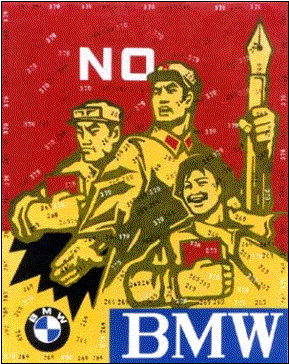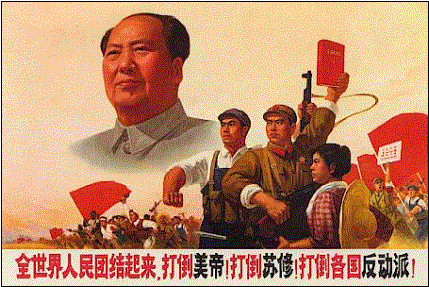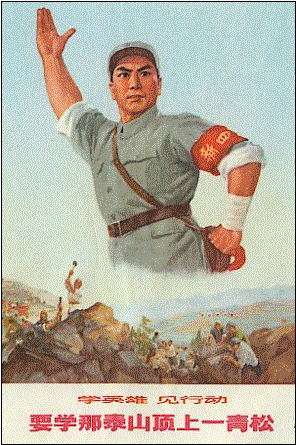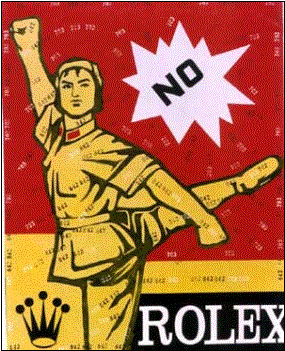THE PAINTINGS OF WANG GUANGYI: REVOLUTIONARY
ACTS?
by David Spalding
The paintings of Wang Guangyi belong to the category of Chinese
contemporary art termed Political Pop: work that appropriates the visual tropes
of the propaganda of the Cultural Revolution, reworking them in the flat,
colorful style of American Pop. To understand the works of artists engaged in
this practice, it is important to recognize the significance and specificity of
the images they are using to fashion their work. Without this knowledge, the
work of artists like Wang Guangyi may be reduced to a mere aestheticization of
the experiences of the Cultural Revolution, a view which threatens to limit the
discussion of these works to their formal elements, foreclosing more important
ideological and historical questions that must be raised. It is perhaps equally
essential, particularly for Western audiences, to keep in mind the dominance
that the Maoist regime held over visual culture and artistic production in China
from 1949 to 1976, a control that reached a near totality between 1966 and 1972,
during the Gang of Four’s reign[i].
Certainly, the vast legacy of propaganda that resulted from this period will
continue to impact artists interested in critically examining China’s recent
visual history. After all, these images were more than simply popular; for a
time, they were the only ones allowed.
During the mid-1990s, as China’s rapidly changing economic system
transformed to accommodate the demands of the global marketplace, a rush of
luxury goods became available to newly wealthy developers and entrepreneurs. In
Wang Guangyi’s The Great Criticism series (1998),
the artist responds to the influx of a new visual regime: those advertising
images promoting newly available, high-priced commodities. In the resulting oil
paintings, Wang stages conflicts between classical figures of propaganda and the
onslaught of luxury consumer goods entering 
 China. In the first propaganda image below, three
heroes of the revolution seem to be manning the front lines of ideology, as
Chairman Mao floats above them like a benevolent and watchful god. From left to
right the costumes of these three identify them as an industrial laborer, a
soldier in the People’s Liberation Army, and a farmer—examples of “red”
people, proletariat who would pave the way for the future. The caption below
captures the ferocity of their revolutionary zeal: “People around the world,
unite! Abolish American Imperialism! Abolish Soviet Reactionaries! Abolish
Counter-revolutionaries throughout the country![ii]”
The intense animosity of this trio is harnessed and redeployed by Wang Guangyi
in The Great Criticism [BMW] (1998),
in which the same three figures look defiantly out toward the future of free
enterprise and utter a resounding “No!” But what, exactly, is being refused?
What is
China. In the first propaganda image below, three
heroes of the revolution seem to be manning the front lines of ideology, as
Chairman Mao floats above them like a benevolent and watchful god. From left to
right the costumes of these three identify them as an industrial laborer, a
soldier in the People’s Liberation Army, and a farmer—examples of “red”
people, proletariat who would pave the way for the future. The caption below
captures the ferocity of their revolutionary zeal: “People around the world,
unite! Abolish American Imperialism! Abolish Soviet Reactionaries! Abolish
Counter-revolutionaries throughout the country![ii]”
The intense animosity of this trio is harnessed and redeployed by Wang Guangyi
in The Great Criticism [BMW] (1998),
in which the same three figures look defiantly out toward the future of free
enterprise and utter a resounding “No!” But what, exactly, is being refused?
What is
 being criticized?
being criticized?
 Similarly, Wang Guangyi’s The
Great Criticism [Rolex] (1998) appropriates the image of a Chinese ballet
dancer, a member of one of the revolutionary dance troops which used a Western
dance form, imported from Russia, to communicate tales of revolution to the
masses. These troops were very popular at a time when all forms of cultural
expression—including Peking Opera and other theatre forms—were re-worked to
express Maoist ideology. The text below the dancer reads: “Learn how to act by
watching a hero. You must become as strong as that pine tree on top of Titian
Mountain.” The female counterpart of this figure appears in Wang’s The Great Criticism [Rolex] (1998), perhaps displaying her athletic
strength and prowess to ward off the appeal of the watchmaker.
Similarly, Wang Guangyi’s The
Great Criticism [Rolex] (1998) appropriates the image of a Chinese ballet
dancer, a member of one of the revolutionary dance troops which used a Western
dance form, imported from Russia, to communicate tales of revolution to the
masses. These troops were very popular at a time when all forms of cultural
expression—including Peking Opera and other theatre forms—were re-worked to
express Maoist ideology. The text below the dancer reads: “Learn how to act by
watching a hero. You must become as strong as that pine tree on top of Titian
Mountain.” The female counterpart of this figure appears in Wang’s The Great Criticism [Rolex] (1998), perhaps displaying her athletic
strength and prowess to ward off the appeal of the watchmaker.
It is important to note that there is not a consensus about the critical
intent of Wang Guangyi’s work. In fact, some critics have been particularly
strong in their rejection of his paintings, as well as those by other Political
Pop artists, finding fault with the artists for tapping into the manipulative
power of propaganda imagery without adequately subverting its meaning. In other
words, Wang can be seen as extracting cultural capital from a history of
suffering, providing easy answers without asking too many difficult questions.
This suspicion is compounded by the fact that the artist’s works have become
valuable commodities, having circulated perhaps too easily into the Western art
market. Critics ask: Isn’t such commodification exactly what Wang Guangyi is
supposed to be critiquing? Curator and art writer Gao Minglu has expressed these
feelings quite strongly:
They
[Political Pop artists] have become a part of an upper-middle class in the
changing Chinese economy. The artists no longer strive to produce a
confrontation with authority and the public as their predecessors did; they have
changed from elite/ amateur avant-gardists to professional, careerist
artists…the nationalism and materialism of Political Pop, based on the
transnational political and economic circumstances, share common roots with
government policy, and the art is in a position of complicity.[iii]
I respect the demand that a great deal
of caution be exercised when tapping into the images of a fascist regime. Still,
I can’t help but be reminded of the criticism of those Western artists in the
1970’s and 80’s who, while developing poignant strategies of appropriation
and mimicry, were accused of self-exploitation and even pornography.
The value of Wang’s works—and others like them—is their ability to
resist absolute clarity, instead creating a surprising tension between consumer
and Maoist imagery. Without being overtly critical—refusing the tactic of
direct accusation that often short-circuits more provocative discussion—Wang
is able to call into question both the capitalist and communist symbols in his
work, allowing us to see them as conflicting and competing precisely because of
their mutual insistence on hegemony. In this way, the artist is indicating the
uneasy points of confluence between China’s Maoist past and its promising
economic future. These paintings suggest that resistance or protest in the
visual arts is deeply dependent of the cultural context in which works are made.
For while Wang Guangyi’s works may be read as a critique of China’s new
economics today, they may have passed—with slight modification—for
government propaganda not too long ago. It is precisely this polyvalence in Wang
Guangyi’s paintings that is their greatest strength.
[i]For a detailed Maoist account
of these events, see “Chinese Art in Revolution,” in Maoist
International Movement, author unknown, http://www.etext.org/Politics/MIM/mt/mt13chinart.html
[ii] Special thanks to Frank Mok
for his translation of this and other texts, as well as for his invaluable
historical insights throughout this project
[iii]
Gao Minglu, “Toward a
Transnational Modernity: An Overview of Inside
Out: New Chinese Art (San Francisco/New York/Berkeley: San Francisco Museum
of Modern Art/Asia Society Galleries/University of California Press, 1998) p.30




 China. In the first propaganda image below, three
heroes of the revolution seem to be manning the front lines of ideology, as
Chairman Mao floats above them like a benevolent and watchful god. From left to
right the costumes of these three identify them as an industrial laborer, a
soldier in the People’s Liberation Army, and a farmer—examples of “red”
people, proletariat who would pave the way for the future. The caption below
captures the ferocity of their revolutionary zeal: “People around the world,
unite! Abolish American Imperialism! Abolish Soviet Reactionaries! Abolish
Counter-revolutionaries throughout the country![ii]”
The intense animosity of this trio is harnessed and redeployed by Wang Guangyi
in The Great Criticism [BMW] (1998),
in which the same three figures look defiantly out toward the future of free
enterprise and utter a resounding “No!” But what, exactly, is being refused?
What is
China. In the first propaganda image below, three
heroes of the revolution seem to be manning the front lines of ideology, as
Chairman Mao floats above them like a benevolent and watchful god. From left to
right the costumes of these three identify them as an industrial laborer, a
soldier in the People’s Liberation Army, and a farmer—examples of “red”
people, proletariat who would pave the way for the future. The caption below
captures the ferocity of their revolutionary zeal: “People around the world,
unite! Abolish American Imperialism! Abolish Soviet Reactionaries! Abolish
Counter-revolutionaries throughout the country![ii]”
The intense animosity of this trio is harnessed and redeployed by Wang Guangyi
in The Great Criticism [BMW] (1998),
in which the same three figures look defiantly out toward the future of free
enterprise and utter a resounding “No!” But what, exactly, is being refused?
What is
 being criticized?
being criticized? 
